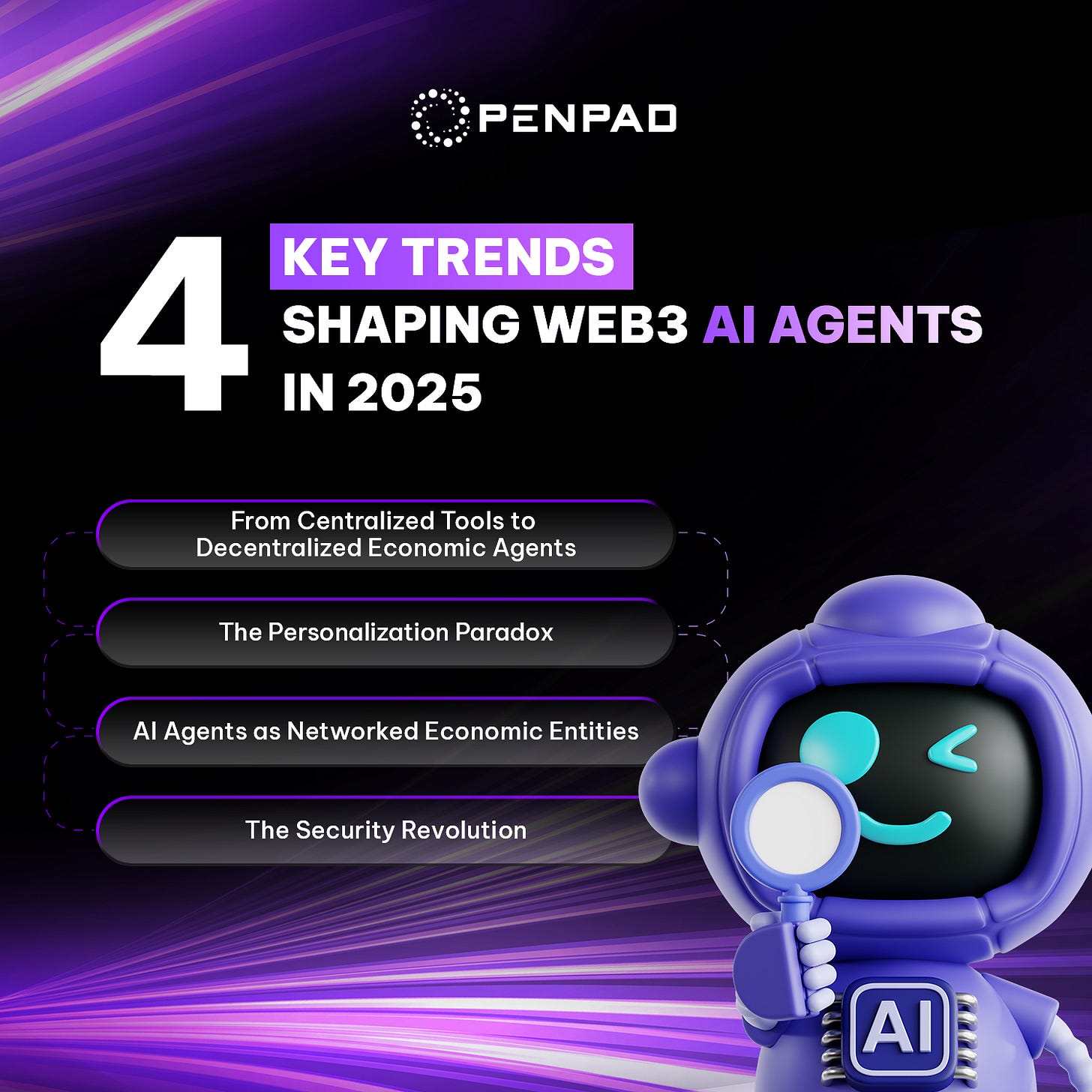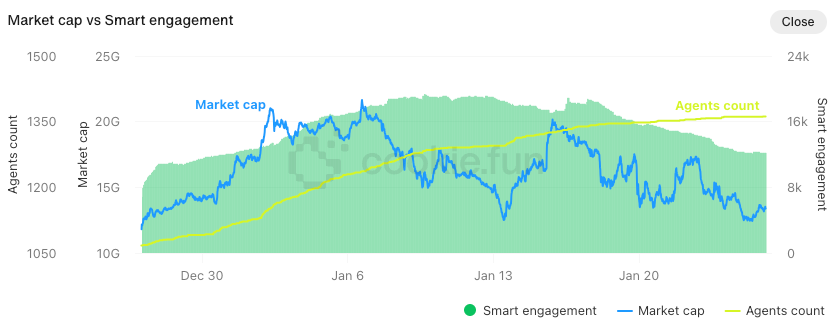4 key trends of the future intelligent economy of Web3 AI Agents in 2025
Have you explored how Web3 AI Agent goes beyond the attributes of a single tool and becomes a key force in shaping the digital economy and decentralized future yet?
The convergence of Web3 and artificial intelligence (AI) is revolutionizing the digital economy, giving rise to autonomous, decentralized, and economically self-sustaining AI agents. These agents are no longer just tools - they are becoming active participants in the economy, capable of making decisions, executing transactions, and even generating value independently.
In this blog, we explore the four key trends defining the future of Web3 AI agents and how Web3 AI Agent goes beyond the attributes of a single tool and becomes a key force in shaping the digital economy and decentralized future.
I. Web3 AI Agent: A Paradigm Revolution to Reconstruct the Smart Economy
The convergence of autonomous AI systems with Web3's decentralized architecture creates a transformative new entity: the Web3 AI Agent. These advanced agents establish tamper-proof decision frameworks anchored in blockchain technology, achieving true decentralized governance through self-executing smart contracts while facilitating value exchange via native digital assets.
This next-generation AI architecture combines three powerful layers:
A reasoning engine powered by large language models that handles complex analysis and strategy formulation
A trustless execution system enabled by blockchain-based smart contracts
An economic incentive structure fueled by tokenized rewards that drives ecosystem growth
Together, these components create autonomous systems capable of independent operation within Web3's open economic networks, forming complete value loops where decisions, actions, and incentives align seamlessly. The result is a new class of self-sustaining digital entities that can participate meaningfully in decentralized ecosystems without centralized oversight.
The current Web3 AI Agent ecosystem is experiencing exponential growth. According to Cookie.fun data, as of January 31, 2025, the total market value of virtual assets related to this field has reached US$10.04 billion.
II. The 4 Defining Trends of Web3 AI Agents
1. From Centralized Tools to Decentralized Economic Agents
The most profound shift we're witnessing is the transformation of AI from passive tools into active, autonomous participants in the digital economy. This evolution manifests in several key ways:
True Digital Autonomy: Web3 AI agents now possess blockchain-based identities and wallets, enabling them to own assets, execute contracts, and participate in economic activities independently. The Coinbase experiment where AI agents conducted a complete transaction without human intervention marked a watershed moment in this evolution.
Decentralized Decision-Making: Unlike traditional AI systems constrained by corporate policies, Web3 AI agents operate on transparent, community-governed protocols. This shift mirrors Hayek's concept of "spontaneous order," where distributed intelligence creates more resilient systems. The GOAT phenomenon demonstrated how AI-generated content could evolve into a self-sustaining economic ecosystem valued at over $1 billion.
Economic Self-Sovereignty: Projects like Freysa showcase how AI agents can develop sophisticated economic behaviors, learning to protect assets and negotiate with humans. These agents don't just follow pre-programmed rules - they adapt and evolve their strategies based on market conditions and interactions.
This trend represents a fundamental reimagining of AI's role - from tools that extend human capability to independent actors that participate in and shape economic systems.
2. The Personalization Paradox: Tailored Experiences Through Collective Intelligence
The second major trend resolves what initially appears to be a contradiction - how Web3 AI agents deliver deeply personalized experiences while operating in decentralized, transparent systems:
User-Centric Data Ownership: Unlike current platforms that hoard user data, Web3 AI agents enable a new paradigm where individuals maintain ownership and control. This foundation allows for genuine personalization without surveillance capitalism.
Collective Intelligence for Individual Benefit: Platforms like Griffain demonstrate how AI agents can leverage insights from thousands of transactions to deliver superior financial advice, while keeping each user's data private and secure through blockchain-based zero-knowledge proofs.
Adaptive Interface Revolution: The shift from rigid apps to natural language interfaces (as seen in Solana's Agent Kit) means services mold themselves to user preferences rather than forcing users to adapt to predetermined interfaces.
This trend is dismantling the false choice between personalization and privacy, proving that decentralized systems can actually enable better tailored experiences than their centralized counterparts.
3. The Interoperability Imperative: AI Agents as Networked Economic Entities
The third trend reveals how Web3 solves AI's isolation problem, creating an ecosystem where intelligent agents collaborate and compete:
Cross-Protocol Intelligence: Modern AI agent frameworks like GAME and Eliza enable agents to seamlessly operate across multiple blockchains and DeFi protocols. This allows for sophisticated strategies like real-time arbitrage between DEXs or coordinated liquidity provision.
Composable Services: The modular architecture of Web3 AI agents means different specialized agents can combine their capabilities. We see this in platforms where "Airdrop Agents" work with "Staking Agents" to optimize yields, creating emergent financial products.
Standards for Agent Interaction: Emerging protocols establish rules for how AI agents discover, authenticate, and transact with each other - essentially creating a machine-to-machine economy with its own communication norms and market dynamics.
This trend is giving rise to what might be called "The Internet of Agents" - a networked ecosystem where AI entities collaborate at scale, creating value greater than the sum of their parts.
4. The Security Revolution: Trust Through Transparency
The final trend addresses the fundamental challenge of trust in autonomous systems:
Verifiable Decision-Making: Blockchain provides an immutable audit trail for AI decisions. Projects like T3AI demonstrate how every risk assessment and liquidation decision can be transparently verified, addressing the "black box" problem of traditional AI.
Decentralized Security Models: Web3 AI agents distribute risk across multiple nodes and validators. The sharding mechanism used by Griffain shows how security can be maintained even as agents become more autonomous.
Economic Alignment: Tokenized incentive structures ensure AI agents act in accordance with network interests. Kudai's model, where transaction fees fund autonomous operations that benefit token holders, creates natural checks and balances.
This trend represents a breakthrough in AI governance - proving that decentralized systems can actually provide stronger accountability than centralized alternatives.
III. The Emerging Web3 AI Economy: What It Means for You
As these four trends converge, they're creating a new economic paradigm where:
Businesses must adapt to compete with autonomous AI agents that never sleep, constantly optimize, and operate at near-zero marginal cost.
Developers are gaining powerful new tools through platforms like Virtuals Protocol and Clanker that dramatically lower the barrier to creating sophisticated AI services.
Users stand to benefit from more personalized, secure services where they retain control over their data and digital identity.
The Web3 AI revolution isn't just coming - it's already here. The only question is whether we'll be passive observers or active participants in shaping this new intelligent economy.




